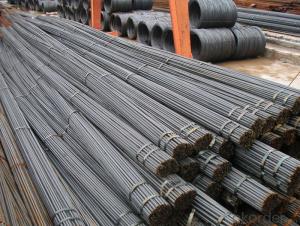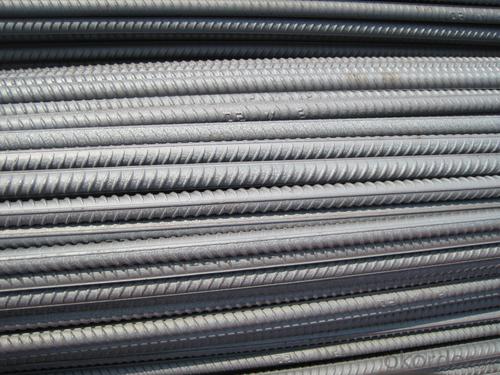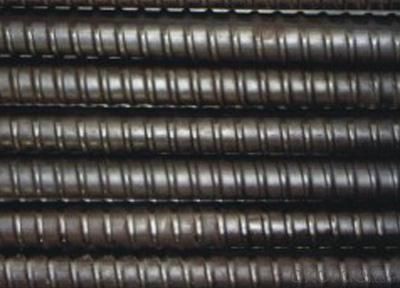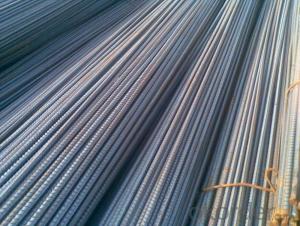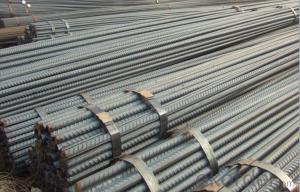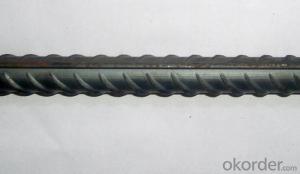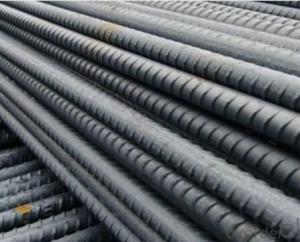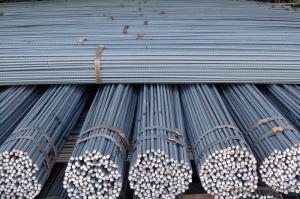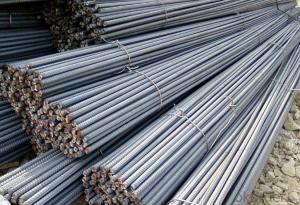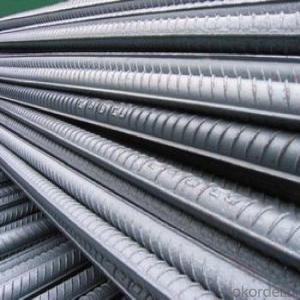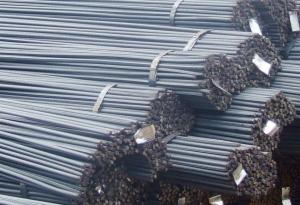Hot Rolled Carbon Steel Rebar 16-25mm with High Quality
- Loading Port:
- China Main Port
- Payment Terms:
- TT or LC
- Min Order Qty:
- 25 m.t.
- Supply Capability:
- 10000 m.t./month
OKorder Service Pledge
OKorder Financial Service
You Might Also Like
Product Description:
OKorder is offering Hot Rolled Carbon Steel Rebar 16-25mm with High Quality at great prices with worldwide shipping. Our supplier is a world-class manufacturer of steel, with our products utilized the world over. OKorder annually supplies products to European, North American and Asian markets. We provide quotations within 24 hours of receiving an inquiry and guarantee competitive prices.
Product Applications:
Hot Rolled Carbon Steel Rebar 16-25mm with High Quality is widely used in buildings, bridges, roads and other engineering construction. Big to highways, railways, bridges, culverts, tunnels, public facilities such as flood control, dam, small to housing construction, beam, column, wall and the foundation of the plate, deformed bar is an integral structure material. With the development of world economy and the vigorous development of infrastructure construction, real estate, the demand for deformed bar will be larger and larger..
Product Advantages:
OKorder's Hot Rolled Carbon Steel Rebar 16-25mm with High Quality are durable, strong.packed and suitable for construction
Main Product Features:
· Premium quality
· Prompt delivery & seaworthy packing (30 days after receiving deposit)
· Can be recycled and reused
· Mill test certification
· Professional Service
· Competitive pricing
Product Specifications:
Manufacture: Hot rolled
Grade: HRB335 HRB400 BS4449 Grade460 ASTM Grade40 Grade60
Certificates: ISO, SGS, BV, CIQ
Length:6m 8m 9m 12m
Packaging: Export packing, packed by coil
FAQ:
Q1: Why buy Materials & Equipment from OKorder.com?
A1: All products offered byOKorder.com are carefully selected from China's most reliable manufacturing enterprises. Through its ISO certifications, OKorder.com adheres to the highest standards and a commitment to supply chain safety and customer satisfaction.
Q2: How do we guarantee the quality of our products?
A2: We have established an advanced quality management system which conducts strict quality tests at every step, from raw materials to the final product. At the same time, we provide extensive follow-up service assurances as required.
Q3: How soon can we receive the product after purchase?
A3: Within three days of placing an order, we will begin production. The specific shipping date is dependent upon international and government factors, but is typically 7 to 10 workdays.
Q4: How many tons per bundle?
A4: Around 2-3tons
Q5: How to avoid the rust after deliver the goods to the loading port?
A5: We will keep the goods at the port covered with water-proof material
Q6: What is the chemical composition and physical properties of HRB400?
A6:
Grade | Technical data of the original chemical composition (%) | ||||||
C | Mn | Si | S | P | V | ||
HRB400 | ≤0.25 | ≤1.60 | ≤0.80 | ≤0.045 | ≤0.045 | 0.04-0.12 | |
Physical capability | |||||||
Yield Strength (N/cm²) | Tensile Strength (N/cm²) | Elongation (%) | |||||
≥400 | ≥570 | ≥14 | |||||
Q7:What is the weight per meter for the common sizes:
A7:
Diameter(mm) | Section area (mm²) | Mass(kg/m) | Weight of 12m bar(kg) |
10 | 78.54 | 0.617 | 7.404 |
12 | 113.1 | 0.888 | 10.656 |
14 | 153.9 | 1.21 | 14.52 |
16 | 201.1 | 1.58 | 18.96 |
18 | 254.5 | 2.00 | 24 |
20 | 314.2 | 2.47 | 29.64 |
22 | 380.1 | 2.98 | 35.76 |
25 | 490.9 | 3.85 | 46.2 |
28 | 615.8 | 4.83 | 57.96 |
32 | 804.2 | 6.31 | 75.72 |
36 | 1018 | 7.99 | 98.88 |
40 | 1257 | 9.87 | 118.44 |
50 | 1964 | 15.42 | 185.04 |
Images:
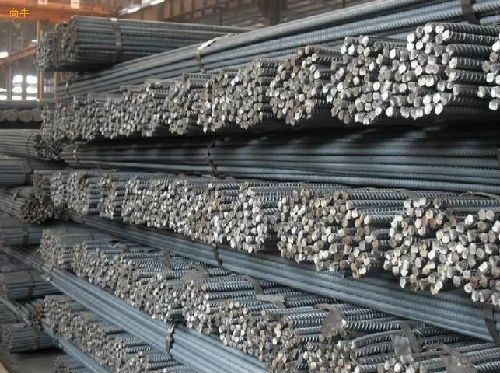
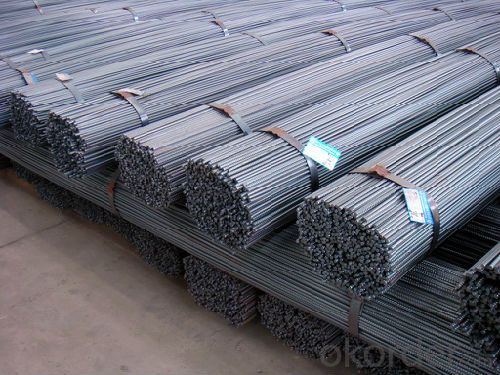
- Q: How do steel rebars prevent cracks and structural failures?
- Steel rebars prevent cracks and structural failures by providing reinforcement and strength to concrete structures. When embedded in concrete, rebars enhance the tensile strength of the overall structure, enabling it to withstand applied forces and loads without cracking or failing. The presence of rebars helps distribute stress and load more evenly throughout the concrete, reducing the likelihood of cracks and failures.
- Q: Can steel rebars be welded together?
- Yes, steel rebars can be welded together. Welding is a common method used to join steel rebars in construction projects, ensuring a strong and durable connection between the rebars.
- Q: What is the weight of steel rebars per meter or foot?
- The weight of steel rebars per meter or foot can vary depending on the size and type of rebar being used. On average, a mild steel rebar typically weighs around 0.44 pounds per foot or 0.67 kilograms per meter. However, it is important to note that different rebar sizes and compositions can result in different weights.
- Q: How are steel rebars bent on-site?
- Steel rebars are typically bent on-site using specialized machinery called rebar benders. These machines are designed to provide the necessary force and precision to bend the rebars to the desired shape and angle. The process starts by measuring and marking the location where the rebar needs to be bent. Then, the rebar is placed into the rebar bender, which is equipped with adjustable rollers and bending arms. The rollers help guide the rebar through the bending process, while the bending arms apply force to gradually bend the rebar to the desired angle and shape. The operator of the rebar bender carefully adjusts the rollers and bending arms to ensure the correct bend radius and angle are achieved. This requires skill and experience to ensure the rebars are bent accurately according to the construction plans and specifications. Once the rebar has been bent to the desired shape, it is then securely fastened in place using tie wire or rebar clips. This ensures that the rebars maintain their shape and position during the concrete pouring process. Bending rebars on-site offers several advantages. Firstly, it allows for greater flexibility and adaptability during construction, as rebars can be customized and adjusted to fit specific design requirements. Secondly, on-site bending minimizes transportation and storage costs, as rebars can be delivered in longer lengths and bent as needed. Lastly, on-site bending saves time and improves construction efficiency, as rebars can be bent and installed immediately, eliminating the need for off-site fabrication and transportation delays. Overall, steel rebars are bent on-site using specialized rebar benders, which provide the necessary force and precision to bend the rebars to the desired shape and angle. This process offers flexibility, cost savings, and improved construction efficiency.
- Q: Can steel rebars be used in precast or prestressed concrete?
- Precast or prestressed concrete can indeed incorporate steel rebars. These reinforcing bars, otherwise referred to as steel rebars, are frequently utilized in precast and prestressed concrete constructions to bolster their strength and endurance. Typically, the rebars are embedded within the concrete matrix to effectively withstand the pulling forces that may arise during the structure's lifespan. By utilizing steel rebars, the structural integrity and load-bearing capacity of precast or prestressed concrete components are heightened, enabling them to endure heavier loads and mitigating the risk of failure. Moreover, steel rebars also aid in the transmission of stresses between different sections of the precast or prestressed concrete elements, ensuring an even distribution of forces and augmenting the overall performance of the structure. Consequently, steel rebars are widely employed in precast and prestressed concrete construction to enhance the structural properties and longevity of the final product.
- Q: The difference between wire and thread steel, wire and thread steel difference knowledge
- The surface of the ribbed steel is ribbed, the ordinary hot-rolled bar is HRB, and the fine grained hot rolled steel bar is HRBF. The main use of thread steel: widely used in housing, bridges, roads and other civil engineering construction. Rebar main origin: steel manufacturers in China are mainly distributed in the north and northeast, North China, Tang Gang, such as Shougang steel, bearing steel, such as the northeast northwest Taiwan, Fushun Steel, these two regions accounted for more than 50% of the total output of thread steel.
- Q: How are steel rebars used in bridge construction?
- Steel rebars are used in bridge construction to reinforce the concrete structures, providing strength and durability. They are placed within the concrete to withstand tension forces and prevent cracking or collapsing of the bridge.
- Q: Can steel rebars be used in architectural concrete elements?
- Yes, steel rebars can be used in architectural concrete elements. Steel rebars are commonly used in concrete construction to provide reinforcement and increase the strength and durability of the concrete structure. In architectural concrete, rebars can be strategically placed to enhance the structural integrity of the elements while also adding aesthetic value. The rebars can be exposed or hidden within the concrete, depending on the desired design outcome. By using steel rebars, architects have the flexibility to create complex and unique architectural elements while ensuring the required strength and stability.
- Q: How do steel rebars perform in fire-resistant constructions?
- Due to their inherent properties, steel rebars are highly effective in fire-resistant constructions. The utilization of steel rebars in these structures serves to bolster their fire resistance. Steel possesses a high melting point and exhibits exceptional heat transfer properties, rendering it a dependable material in fire scenarios. When subjected to elevated temperatures, steel rebars do not undergo combustion or emit toxic fumes, crucially ensuring the safety of individuals during a fire incident. Furthermore, steel rebars possess a low coefficient of thermal expansion, signifying that they experience minimal expansion when exposed to heat. This characteristic helps to maintain the structural integrity of fire-resistant constructions, thereby averting potential structural failures during a fire. Additionally, steel rebars boast high tensile strength, which significantly contributes to the overall performance of the structure in fire conditions. This strength enables the rebars to withstand the forces generated by the concrete's expansion due to heat, thereby reducing the risk of cracking or spalling. Moreover, steel rebars can be encased in fire-resistant materials like concrete and fireproof coatings to provide an additional layer of protection against fire. This combination of steel and fire-resistant materials produces a robust system that effectively endures high temperatures and prolongs the construction's structural stability in the event of a fire. In conclusion, steel rebars play a vital role in fire-resistant constructions. Their high melting point, low thermal expansion, and exceptional tensile strength make them a dependable choice for enhancing the fire resistance of structures. By incorporating steel rebars into construction designs, the safety and durability of buildings are significantly enhanced, affording occupants valuable time to evacuate and minimizing the potential for structural damage during a fire incident.
- Q: What is the role of steel rebars in minimizing the risk of concrete spalling due to sulfate attack?
- Steel rebars play a crucial role in minimizing the risk of concrete spalling due to sulfate attack by providing reinforcement and increasing the overall strength of the concrete structure. When concrete is exposed to sulfate ions, it can undergo a chemical reaction that leads to expansion and cracking, resulting in spalling. However, steel rebars act as a reinforcement, helping to distribute the stress and load throughout the concrete, reducing the risk of cracking and spalling. Additionally, the presence of rebars helps to maintain the structural integrity of the concrete, preventing the ingress of sulfate ions and minimizing the potential for sulfate attack.
Send your message to us
Hot Rolled Carbon Steel Rebar 16-25mm with High Quality
- Loading Port:
- China Main Port
- Payment Terms:
- TT or LC
- Min Order Qty:
- 25 m.t.
- Supply Capability:
- 10000 m.t./month
OKorder Service Pledge
OKorder Financial Service
Similar products
Hot products
Hot Searches
Related keywords

